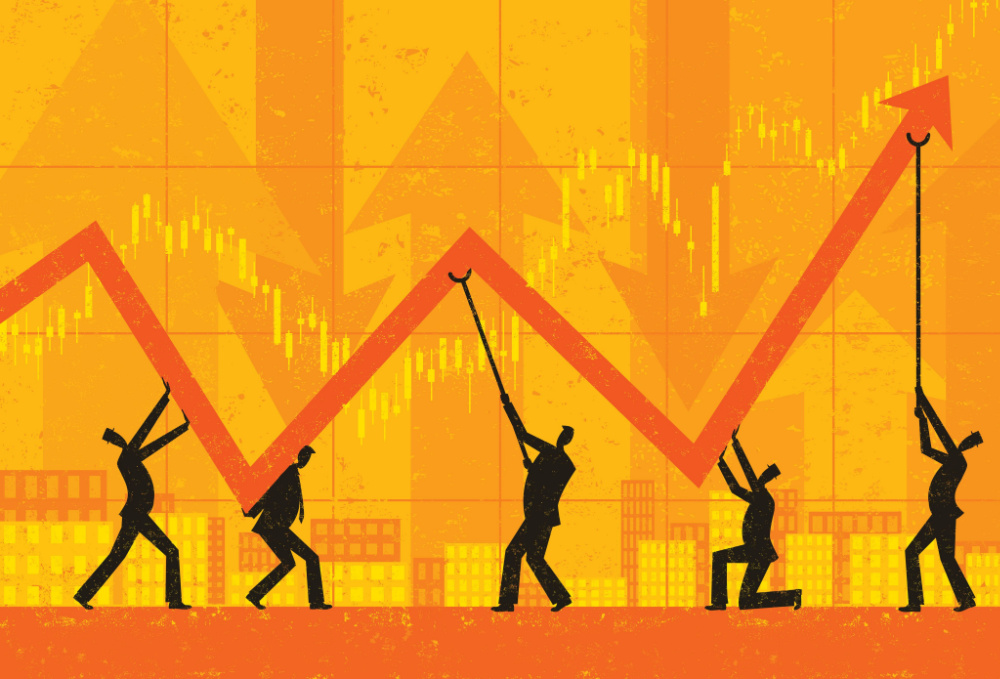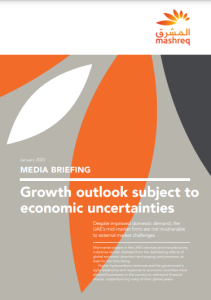UAE mid-market growth outlook subject to economic uncertainties

Despite improved demand conditions, the UAE’s mid-market firms are not invulnerable to external market challenges
- Mid-market firms in the UAE must gear up to face potentially choppy business conditions
- Macroeconomic challenges including inflation, rising interest rates and supply chain delays are impacting already thin profit margins
- The GCC’s economies are projected to grow 6.9 per cent in 2022 before moderating to 3.7 per cent and 2.4 per cent in 2023 and 2024, according to the World Bank
- The growth forecast is however, caveated by geo-political risks such as the Russia-Ukraine war and China’s zero-Covid policy
Download the latest insights from Mashreq
Mid-market players in the UAE’s services and manufacturing industries remain shielded from the debilitating effects of the global economic downturn and surging cost pressures, at least for the time being.
Higher hydrocarbons revenues and the government’s agile leadership and response to economic severities have allowed businesses in the country to withstand financial shocks and outperform many of their global peers.
But experts are concerned that if the market does not improve, the outlook could darken over the coming months.
“The fact of the matter is that there are headwinds. We cannot deny or ignore this,” says Hind Eisa Salim, executive vice-president and head of services and manufacturing at Mashreq Bank.
“Businesses in the UAE are blessed by the swift measures taken by the authorities since the Covid-19 pandemic. But the UAE’s economy and its source markets are global – and external issues will ultimately affect businesses.”
Moreover, industries around the world continue to be buffeted by mitigating factors that are external and uncontrollable in nature. Pandemic-induced supply chain issues persist, while rising interest rates, container and fuel costs, and higher commodity prices on the back of the Russia-Ukraine war are exerting downward pressure.
Outperformed expectations
The combination of sustained oil prices and non-oil sector growth have ensured the UAE continues its post-Covid recovery momentum, despite the worsening global economic climate.
If more evidence of this was required, the seasonally adjusted S&P Global UAE Purchasing Managers’ Index (PMI) shows that the rate of expansion reached its strongest in over three years during August 2022.
S&P Global, however, reports that businesses are beginning to feel the strain on their capacity due to strong client demand and project backlogs.
Meanwhile, price fluctuations and the scarcer availability of raw materials have made it difficult to accurately forecast profitability and demand, not to mention the uncertainty regarding capital expenditure.
The issue is compounded due to the -thin margins mid-market firms operate on and the fact that they cannot easily pass on the additional costs to their customers, explains Hind Eisa.
“Mid-market players lack the capital resources of larger firms, or the economic support offered to smaller businesses, because they sit somewhere in the middle of the spectrum,” she says. “Their margins are already so tight – and now with the rising costs, they are beginning to struggle.
“Despite global conditions, the UAE remains one of the least impacted countries due to the stable oil prices,” says Hind Eisa.
 Faced with these challenges, Hind Eisa emphasises that banks including Mashreq are keen to support their customers.
Faced with these challenges, Hind Eisa emphasises that banks including Mashreq are keen to support their customers.
“We realise that the costs of borrowing have almost doubled in the past year – an aggressive rise for any business anywhere in the world,” she says. “We’re actively holding conversations with our clients and trying to find out ways to help them survive this period.
“We want our customers to know that we’re on their side. We understand the challenges facing them and want to back them as partners.”
Explore Mashreq’s outlook for mid-market businesses in the UAE


